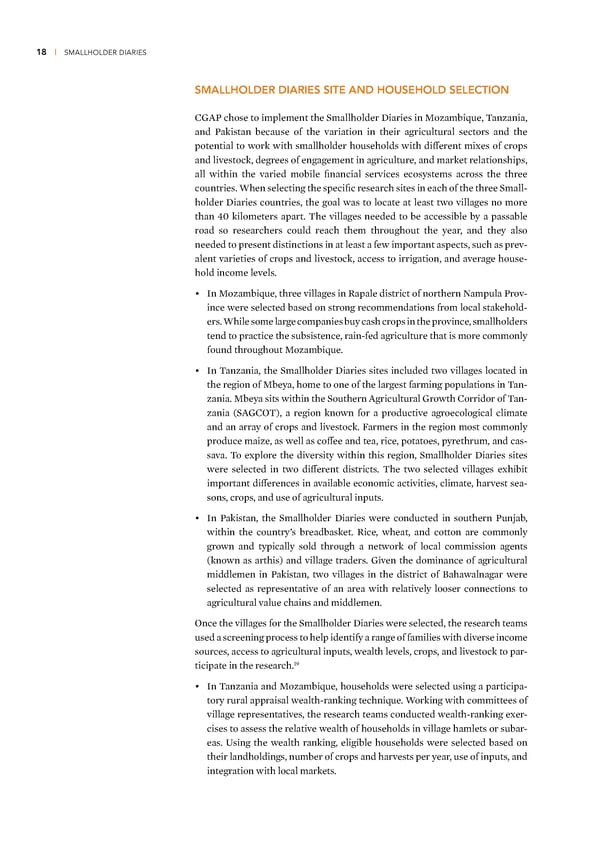18 | SMALLHOLDER DIARIES SMALLHOLDER DIARIES SITE AND HOUSEHOLD SELECTION †‡ˆ chose to implement the Smallholder ‰iaries in –o—ambiue, Œan—ania, and aistan because of the variation in their agricultural sectors and the potential to wor with smallholder households with different mixes of crops and livestoc, degrees of engagement in agriculture, and maret relationships, all within the varied mobile financial services ecosystems across the three countries ™hen selecting the specific research sites in each of the three Small- holder ‰iaries countries, the goal was to locate at least two villages no more than “’ ilometers apart Œhe villages needed to be accessible by a passable road so researchers could reach them throughout the year, and they also needed to present distinctions in at least a few important aspects, such as prev- alent varieties of crops and livestoc, access to irrigation, and average house- hold income levels • €n –o—ambiue, three villages in ªapale district of northern ˜ampula rov- ince were selected based on strong recommendations from local staehold- ers ™hile some large companies buy cash crops in the province, smallholders tend to practice the subsistence, rain-fed agriculture that is more commonly found throughout –o—ambiue • €n Œan—ania, the Smallholder ‰iaries sites included two villages located in the region of –beya, home to one of the largest farming populations in Œan- —ania –beya sits within the Southern ˆgricultural ‡rowth †orridor of Œan- —ania (Sˆ‡†¦Œ), a region nown for a productive agroecological climate and an array of crops and livestoc armers in the region most commonly produce mai—e, as well as coffee and tea, rice, potatoes, pyrethrum, and cas- sava Œo explore the diversity within this region, Smallholder ‰iaries sites were selected in two different districts Œhe two selected villages exhibit important differences in available economic activities, climate, harvest sea- sons, crops, and use of agricultural inputs • €n aistan, the Smallholder ‰iaries were conducted in southern un„ab, within the country’s breadbaset ªice, wheat, and cotton are commonly grown and typically sold through a networ of local commission agents (nown as arthis) and village traders ‡iven the dominance of agricultural middlemen in aistan, two villages in the district of £ahawalnagar were selected as representative of an area with relatively looser connections to agricultural value chains and middlemen ¦nce the villages for the Smallholder ‰iaries were selected, the research teams used a screening process to help identify a range of families with diverse income sources, access to agricultural inputs, wealth levels, crops, and livestoc to par- …ž ticipate in the research • €n Œan—ania and –o—ambiue, households were selected using a participa- tory rural appraisal wealth-raning techniue ™oring with committees of village representatives, the research teams conducted wealth-raning exer- cises to assess the relative wealth of households in village hamlets or subar- eas ©sing the wealth raning, eligible households were selected based on their landholdings, number of crops and harvests per year, use of inputs, and integration with local marets
 Financial Diaries with Smallholder Families Page 28 Page 30
Financial Diaries with Smallholder Families Page 28 Page 30